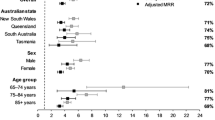Abstract
The proportion of the population over the age of retirement has risen in many countries, and this means there is a corresponding rise in the incidence of hip fractures. However, in order to reliably investigate the ability of interventions to prevent fracture, there needs to be a reliable measure of the incidence of hip fracture. The purpose of this study was to examine the inclusion and exclusion criteria used to identify hip fracture from hospital admission data and to examine the impact that these criteria have on estimated incidence of hip fracture. We examine the influence of: individual compared to consultant episode data; primary data compared to any diagnosis of hip fracture; emergency compared to elective admissions; and the influence of type and rate of surgery on incidence estimates. The results showed that classifying hip fractures by use of consultant episodes overestimated the rate of hip fracture by 6–31%, and this overestimation has increased in recent years. The use of primary diagnosis as opposed to any diagnosis underestimates hip fracture by 5%. Two percent (2%) of the people studied had an operation for a hip fracture but did not have a hip fracture diagnosis (many had a multiple fracture diagnosis), and 5.5% of the people studied had an elective admission for the hip fracture (perhaps falling in hospital during an elective admission). We conclude that the selection criteria can have a great influence on the number of hip fractures identified using routine data. There should be a standardized selection procedure for the identification of hip fracture, as this would enable interventions and preventive measures to be evaluated over time and facilitate comparisons of rates in different regions and countries, in order to examine factors associated with hip fracture.

Similar content being viewed by others
References
Roberts SE, Goldacre MJ (2003) Time trends and demography of mortality after fractured neck of femur in an English population, 1968–1998: database study. BMJ 327(7418):771–775
Todd CJ et al (1995) Differences in mortality after fracture of hip. BMJ 311(7011):1025
Keene GS, Parker MJ, Pryor GA (1993) Mortality and morbidity after hip fractures. BMJ 307(6914):1248–1250
Kannus P et al (1999) Hip fractures in Finland between 1970 and 1997 and predictions for the future. Lancet 353(9155):802–805
Kannus P et al (1996) Epidemiology of hip fractures. Bone 18 [Suppl 1]:57S–63S
Finsen V et al (2004) Hip fracture incidence in central Norway: a follow-up study. Clin Orthop (419):173–178
Fielden J et al (2001) Hip fracture incidence in New Zealand, revisited. N Z Med J 114(1129):154–156
Streeten EA et al (2004) Reduced incidence of hip fracture in the Old Order Amish. J Bone Miner Res 19(2):308–313
(2004) Nationwide survey of hip fractures in Japan. J Orthop Sci 9(1):1–5
Zingmond DS, Melton LJ 3rd, Silverman SL (2004) Increasing hip fracture incidence in California Hispanics, 1983 to 2000. Osteoporos Int 15(8):603–610
Stephenson S et al (2003) Upward trends in the incidence of neck of femur fractures in the elderly. N Z Med J 116(1185):U665
Goldacre MJ, Roberts SE, Yeates D (2002) Mortality after admission to hospital with fractured neck of femur: database study. BMJ 325(7369):868–869
Cryer C et al (2002) Measure for measure: the quest for valid indicators of non-fatal injury incidence. Public Health 116(5):257–262
Gilthorpe MS, Bedi R (1997) An exploratory study combining hospital episode statistics with socio-demographic variables, to examine the access and utilisation of hospital oral surgery services. Community Dent Health 14(4):209–213
Pollock AM, Vickers N (1998) Trends in colorectal cancer care in southern England, 1989–1993: using HES data to inform cancer services reviews. J Epidemiol Community Health 52(7):433–438
Gjini A et al (2004) Capture-recapture analysis and pneumococcal meningitis estimates in England. Emerg Infect Dis 10(1):87–93
Balasegaram S, Majeed A, Fitz-Clarence H (2001) Trends in hospital admissions for fractures of the hip and femur in England, 1989–1990 to 1997–1998. J Public Health Med 23(1):11–17
McColl A, Roderick P, Cooper C (1998) Hip fracture incidence and mortality in an English region: a study using routine National Health Service data. J Public Health Med 20(2):196–205
Cryer PC et al (2000) Why the government was right to change the “Our Healthier Nation” accidental injury target. Public Health 114(4):232–237
(1976) Waterhouse JPC, Muir C, Powell J (eds) Cancer incidence in five continents, vol. 3. IARC, Lyon, France, p 456
Chie WC et al (2004) High incidence rate of hip fracture in Taiwan: estimated from a nationwide health insurance database. Osteoporos Int 15(12):998–1002
Lips P (1997) Epidemiology and predictors of fractures associated with osteoporosis. Am J Med 103(2A):3S–8S; discussion 8S–11S
Author information
Authors and Affiliations
Corresponding author
Rights and permissions
About this article
Cite this article
Brophy, S., John, G., Evans, E. et al. Methodological issues in the identification of hip fractures using routine hospital data: a database study. Osteoporos Int 17, 405–409 (2006). https://doi.org/10.1007/s00198-005-2038-6
Received:
Accepted:
Published:
Issue Date:
DOI: https://doi.org/10.1007/s00198-005-2038-6




